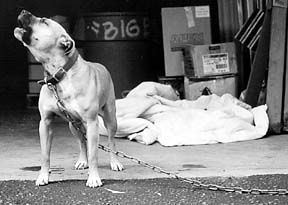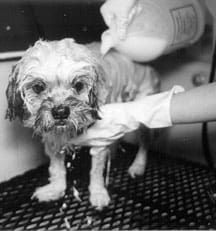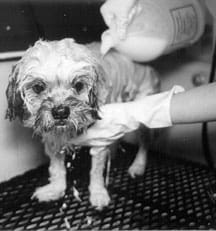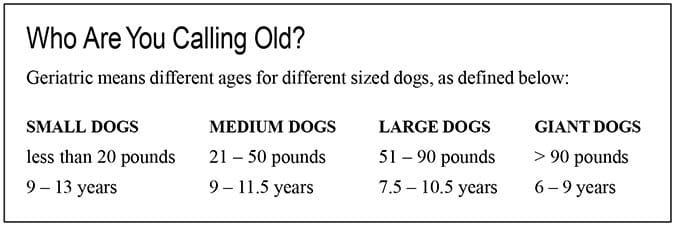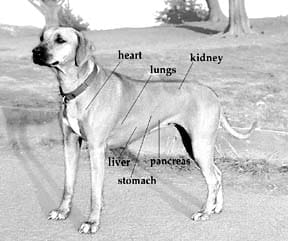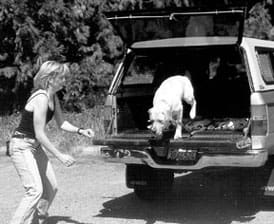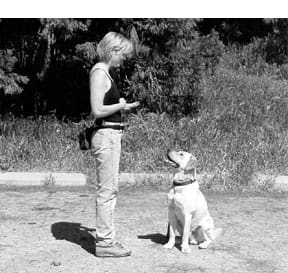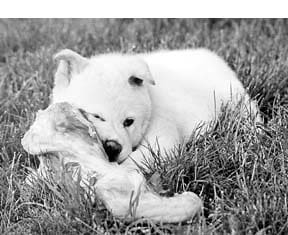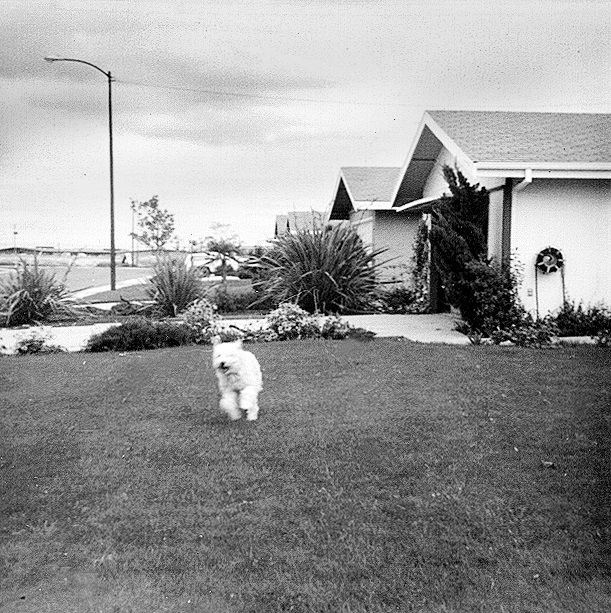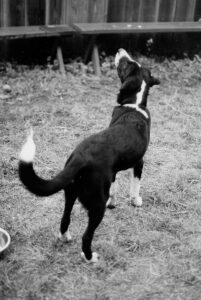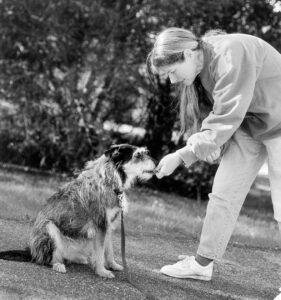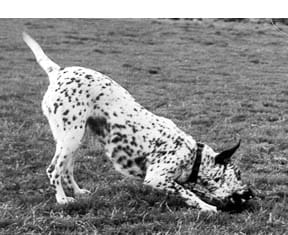I was trying to be a responsible dog owner. We lived in a rural area of Northern California, in a house with no fenced yard. My boyfriend’s Irish Setter had recently been shot and killed while chasing a neighbor’s goats. A hard lesson to learn, and one I wasn’t about to repeat. So when we were leaving the ranch for a day I insisted we tie up our recently acquired St. Bernard, Bear. We tied him to a tree, made sure he had access to plenty of water and shade and was nowhere near a fence that he could climb over. Confident that we had done the right thing, we drove off.
When we returned eight hours later, Bear was dead. His cable had gotten hooked over the stub of a tiny tree branch and he had hung himself. Another hard lesson learned. I swore I would never tie a dog and leave him again, and to this day, some 25 years later, I never have.
What is Your Purpose for Tethering Your Dog?
People tie up their dogs for a number of reasons, but we feel confident that each problem that has motivated the dog’s owner to tie has a better, safer solution. And Whole Dog Journal isn’t the only source that will tell you this.
For example, some dog owners have perfectly serviceable fenced yards but don’t want Digger excavating in the garden or defecating on the manicured lawn. The dog ends up on a chain.
There are better ways to protect the landscaping, either by fencing off a section of the yard for Digger’s use, or building a pen or kennel to keep him out of trouble when he must be confined outdoors. Better yet, take the time to teach him to use a designated spot as his toilet by regularly taking him on his leash to the right spot and rewarding him for using it.
You can also teach a dog to use a digging spot or a box constructed for that purpose rather than the garden. To do this, soften the soil in the designated spot, or build a low wooden frame large enough for him to move around in comfortably and fill it with dirt. Encourage him to use the box or spot by burying a couple of bones or toys and then helping him dig them up. Anytime he starts to dig in another spot, cheerfully redirect him to the right spot.
Other owners tie their dogs in an ill-advised attempt to protect their property from intruders. It’s true that one of the best ways to make a dog aggressive is to tether him. A dog on a chain is vulnerable to teasing and tormenting by humans and other animals. The teasing may not even be deliberate – simply watching others pass by day after day out of his reach can trigger Killer’s prey, protection, and territorial instincts. As his levels of frustration and stress escalate, so does his aggression. In a short time he can become a lethal weapon; wreaking havoc if his chain breaks or someone enters the territory bounded by the radius of the chain.
In 1986, William Berry tied his pit bull in his yard in Morgan Hill, California, to guard his illicit marijuana patch. Tragically, the neighbor’s toddler wandered next door and was killed by the dog. Berry was charged with second degree murder and later convicted of involuntary manslaughter. The dog was euthanized for doing the job that Berry had asked him to do.
But the primary reason most people tie Rover up is to keep him safe at home. They may not have a fenced yard, or Rover may have learned how to escape the fence. Unfortunately, the hazards of tying are great, and the behavioral side effects can be extreme. Dogs who are tied can hang themselves by jumping a fence or, like Bear, by catching their chains on some hidden protrusion. All too often, dogs who are tied live on the chain for 24 hours a day, often without adequate food, water or shelter – lonely, ignored, in abject misery.
Whatever the motivation, none of them are good enough to risk Fido’s life or the lives of others. There are better ways to keep him safe and out of trouble.
Some Better Options Than Tethering
No one likes to get a ticket from the local animal control officer, although that’s the least of the troubles that Rover can get into when he’s roaming free in the real world. Cars, bullets, dognapping, dogfights, and poisoning top the list of lethal hazards he can encounter. He can also do damage to others by chasing bicycles, cars and joggers, terrorizing schoolchildren, mail carriers and cats, tipping over garbage cans, and destroying personal property. Fortunately there are better ways than tying to achieve the safe confinement goal.
The best way to confine your dog is to keep him indoors when you aren’t home. Not only is he not spending hours figuring out how to Houdini his way out of the fence, he is also not barking at every squirrel, deer and pedestrian who passes by, and you don’t have to worry about him being poisoned by a disgruntled neighbor or released accidentally by the meter reader.
If Fido isn’t allowed in the house, shame on you! Dogs are pack animals. In their natural environment they are rarely alone. When we banish him to the backyard, Fido lives a lonely and deprived existence, and may escalate his escape efforts in search of companionship.
Some dog owners mistakenly shut Fido outside as a puppy, fully intending to allow him in “once he grows up and learns house manners.” He can’t learn house manners exiled to the back yard! He learns by being indoors, being rewarded for doing the right things and prevented from making mistakes through owner supervision and vigilance.
A dog who lives indoors tends to sleep a good part of the day while the owner is away. He is in the pack’s “cave,” and there are plenty of reminders of his pack members (you!) to reassure him that he has not been abandoned.
Containing Your Anxiety-Prone Dog
If Fido is destructive when left alone he may just need some diversions to keep him occupied, or you may have a separation anxiety challenge. Either way, you need to create a dog-safe room (or enclose him in an exercise pen), make sure he gets plenty of exercise before he is left alone, leave him with treat-loaded toys like cream-cheese-filled Kongs, Roll-A-Treat Balls, or Buster Cubes, and teach him interactive games like treat hide-and-seek, where you hide treats and toys around the house so he can spend hours searching for them.
A crate can be a useful tool for keeping Fido out of trouble, but shouldn’t be used in the daytime for more than about four hours at a time. If you are away for the average eight to 10 hour workday, this is not a good solution. It is not advised for dogs with separation anxiety, as they can panic and hurt themselves when confined to a crate.
If your dog suffers from separation anxiety, that is, if he is inordinately vocal or destructive in your absence, and is otherwise housetrained but consistently defecates and urinates in inappropriate places when you leave him alone, you are well advised to seek the services of a local trainer or behaviorist who uses positive training methods. Separation anxiety is a complex problem that requires careful, gentle behavior modification. While owners of dogs who suffer from this syndrome can easily and understandably get angry and frustrated with the damage caused by their agitated canine charges, punishment only makes the dogs’ anxieties worse.
Good Fences Make Good Dogs
If you do leave your dog outside even for short periods of time, a secure, solid fenced yard is the best choice. Solid is best because chain link or see-through wire of any kind allows the dog to be visually stimulated, triggering the same kinds of stress and frustration as tying, which increases barking and barrier aggression.
If you are starting with a puppy who has never learned the dubious joys of running free, you are fortunate. Your fence must be sturdy, and tall enough to discourage any adolescent escape attempts. It is vital that you block all possible escape routes before putting your pup in the yard the first time. If a dog is properly contained during his “formative months,” he is much less likely to try to escape in his later years. If he escapes even once, he will probably try to escape again.
Dogs who never have learned to jump a fence may be effectively contained by a four-foot barrier. But if your puppy learns to scale a three-foot fence, raising the fence to four feet after-the-fact may only teach him to jump or climb higher. When he succeeds at four feet, raising it to five feet will encourage greater athletic endeavors. An ounce of prevention is truly worth several extra feet of fence height! (Make sure that you don’t leave a doghouse, picnic table, wood pile or other climbable object next to the fence to give Rover a boost!)
If Rover has already learned that it’s fun to run, your job will be considerably more challenging. Dogs who jump or climb fences can be discouraged by adding an extension to the top of the fence that leans inward at a 45-degree angle. This makes it difficult for the jumper to accurately gauge the height and location of the top of the fence, and virtually impossible for the climber, since he would have to reach back over his head to grab and climb over the extension.
Planting bushes or putting some other obstacle at the take-off point can also stop a jumper by disrupting his striding. The bottom of your fence should be below ground level to prevent escape by digging. Diggers and fence chewers can often be thwarted by burying woven wire underground or covering the fence with wire. Wire is much less fun to dig or chew through than dirt or wood.
An electric fence may be an acceptable last resort. Although we are not advocates of using electric shock for dog training purposes and don’t recommend the use of electronic, non-visible fences (see, “Pros and Cons of Electric Underground Fences,” WDJ May 1999) if all else fails, you can install a single strand of battery-powered electric fence wire to teach Rover that fences bite. A visible electric wire is far more fair to the dog than a shock collar because the dog can see it; the shock doesn’t come out of nowhere. Most dogs won’t touch the wire more than once or twice before they learn to give the fence a wide berth. Be sure to get a system that uses alternating current and is designed for dogs; some livestock fences may be too strong for canines. You can tie strips of cloth on the wire so it’s easier for the dog (and you!) to see and avoid, and you will want to warn any children who have access to your yard. While the shock won’t cause permanent damage, it would be an unpleasant surprise for an unwary child.
When a Fence Isn’t an Option
Perhaps your yard isn’t fenced, you can’t afford to put one up (or your homeowner’s association prohibits it) and Fido reduces the furniture to splinters if left indoors. Isn’t tying your only option?
Not at all. Chain link kennels are sold at hardware, pet supply, and feed stores. They are relatively inexpensive, can be covered to stop climbers, placed on a cement slab to thwart diggers, and are portable; if you move, you can dismantle the kennel and take it with you.
A cable run, while a slight improvement on a stationary chain because it gives the dog more room to move around, still puts the dog at risk for hanging, aggression, and isolation. It may be an acceptable temporary alternative for a dog who escapes a fence, but only while you are implementing other solutions to keep him safely confined, and only if you are sure he can’t hang, be teased or tormented, and has access to food, water, shelter and human companionship.
Doggie day care is another possibility. Perhaps a dogless neighbor would like some daytime canine companionship, or another dog owner who is home during the day would welcome the diversion for her own dog. Commercial daycare centers are springing up all over the country – there may be one near you! An added benefit is that Fido comes home tired and happy, and is less demanding of your attentions at the end of your own tiring workday.
Tie Downs as Time-Outs
Is there ever a time when it is appropriate to tie a dog? Yes – for a brief period, as a training tool. We recommend the use of a short (three- to five-minute) time-out in your presence wherein Fido is restrained by a four- to five-foot vinyl-coated cable (or short leash, if he won’t chew through it) with a blanket, rug, or dog bed placed where he can relax comfortably on the tie-down. This is useful for teaching him that certain behaviors, usually out-of-control energy or puppy biting, result in a temporary removal from the fun, and can help to teach him house manners.
Don’t be intimidating when giving your exuberant pup a time-out, just gently hook his collar to the tie-down with a cheerful, “Too bad, time-out!” and give him a chew-bone or cream-cheese-stuffed Kong. Then, ignore him until he calms down and settles on his bed (you might need a book or magazine to keep yourself occupied the first few times). A minute or two of calm behavior earns him his freedom. If he gets too wound up again, he gets another time out.
Several repetitions of this routine are usually enough for any dog to realize he has to control himself. Of course, puppies are always confined to an exercise pen or on a leash unless they are under the direct supervision of a responsible human so they don’t learn to be destructive. (See “Preparing For and Training Young Puppies,” WDJ January 1999.)
Many years ago, Bear paid far too high a price for my ignorance about the dangers of tying. If sharing that experience prevents other dogs from suffering a similar fate, I will have finally begun to repay the debt that I owe him for his involuntary sacrifice.
Pat Miller, a dog trainer from Salinas, California, is a regular contributor to WDJ.


